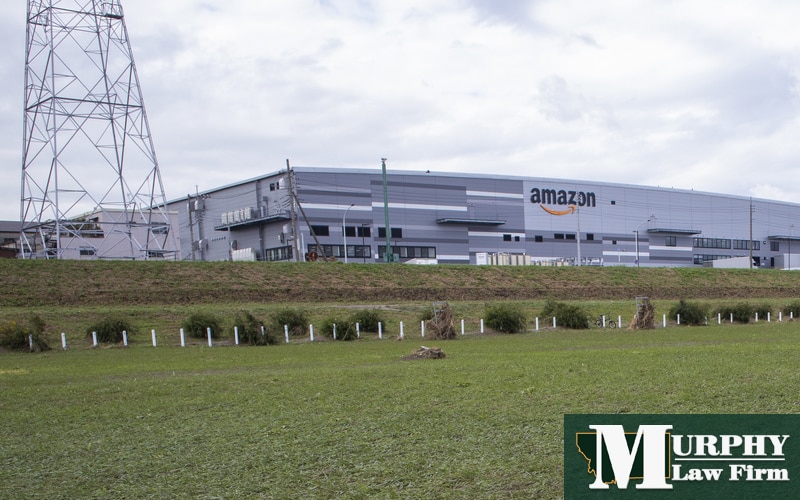Steps to take after you’ve been injured in a Montana Amazon fulfillment warehouse
Nationwide, Amazon has over 1 million employees in the U.S., setting the record for most employees in a single private company. Many of those workers do their jobs in warehouses used to store items that are then shipped to customers.
However, the company’s rapid growth and automation have raised questions about employee safety due to above-average injury rates in their “fulfillment” warehouses. This raises questions about worker rights when it comes to workers’ compensation.
Common Amazon warehouse injuries
According to a study conducted by Reveal from the Center for Investigative Reporting, the rate of serious injury in an Amazon fulfillment center is more than double the national average in warehousing. For every 100 full-time workers, 9.6 suffer serious injury (compared to an industry average of just 4 per 100 workers). Amazon itself reports that injuries are unacceptably high in their warehouses.
The most common types of injuries in Amazon warehouses include:
- Carpal and cubital tunnel syndrome
- Cervical injuries
- Concussions and traumatic brain injuries
- Crush injuries from machinery, shelving or boxes
- Ganglion cysts
- Hernias
- Herniated discs
- Hyperextensions
- Meniscus and ligament tears
- Rotator cuff or labrum tears in the shoulder
- Spinal injuries
Are Amazon workers in Montana eligible for workers’ compensation?
Under Montana law, an Amazon employee who is injured while performing their job duties must be provided workers’ compensation benefits.
This includes full- and part-time workers as well as seasonal and occasional employees. Montana law exempts casual employees who aren’t part of the employee’s usual business.
However, if the casual employee performs core activities of the business, they aren’t exempt from workers’ comp. An employee must file a workers’ compensation claim within 1 year of the injury or illness. The statute of limitations stretches to 2 years if the employee can prove they didn’t know about the injury prior to filing.
What benefits can I receive?
If you are injured at work, workers’ compensation will cover your medical costs and lost wages. You may also receive compensation for travel, medical equipment or at-home treatments you may require as treatment for your injury.
In Montana, you will receive two-thirds of your gross wages up to a maximum set by law each year. If you can work but are earning less than normal due to an injury, you may receive the difference between your actual earnings and your average weekly wage at the time of the injury.
For example, if you are a part-time Amazon employee who was working an average of 25 hours per week when you were injured, but now you are only able to work 10 hours per week, you may be able to receive payment for the 15 hours per week you now can’t work.
If you are completely disabled and unable to work, you could be eligible for permanent total disability benefits paid at the same two-thirds rate that your regular benefits are paid. This ends when you are approved for Social Security disability or retirement benefits.
Lump sum settlements
Many workers’ compensation settlements in Montana are lump-sum settlements. This means that you will receive 1 large payment from the insurance company rather than receiving a check each week. Workers’ compensation payments of any kind are not taxed and you don’t need to report them when you file your taxes at the end of the year in most cases.
However, if you are receiving Social Security disability or payment from multiple insurance claims, it’s possible you may need to pay taxes on the benefits. If your lump sum payment will be significant, you need to speak to a workers’ compensation attorney to be sure your settlement is not taxable.
Workers’ comp is no-fault coverage
Montana workers’ compensation is considered no-fault insurance. This means that you are eligible for coverage even if you are responsible for your injury, in most cases. There are exceptions, such as if you were under the influence of alcohol or drugs. However, if Amazon suspects you caused your injury, their insurance company may attempt to deny your claim.
If that happens, you must send a letter to the insurance company detailing why you disagree with their decision and what you are entitled to receive. If that request is denied, or the insurance company fails to respond within 15 days, you can request a mediation hearing by filing a Petition for Mediation Conference with the Mediation Unit of the Montana Department of Labor and Industry.
If mediation isn’t successful, you may request a hearing before a judge by filing a Petition for Hearing with the same department.
Seek help from a work injury attorney
Amazon is a massive company with deep pockets to pay an army of attorneys to fight your workers’ compensation claim. Although you are permitted to represent yourself at mediation and other hearings, it’s not recommended. After you are injured, it’s in your best interest that you speak to a workers’ compensation attorney.
Hiring an attorney doesn’t mean you plan to sue your employer. In fact, Montana law prevents you from doing so in most cases. Instead, an attorney will look out for your rights to be sure you get the compensation you deserve.




